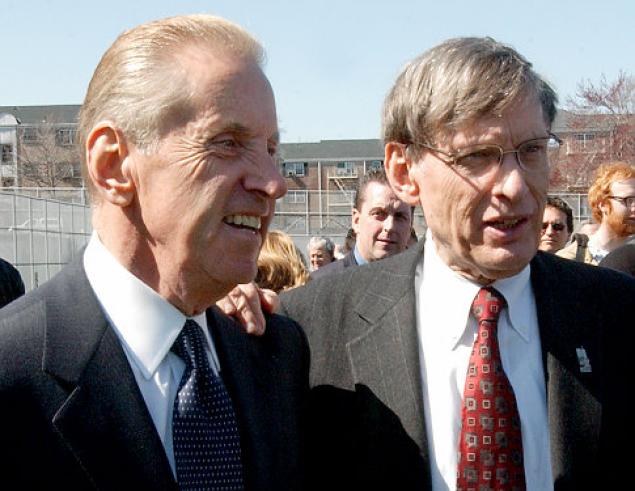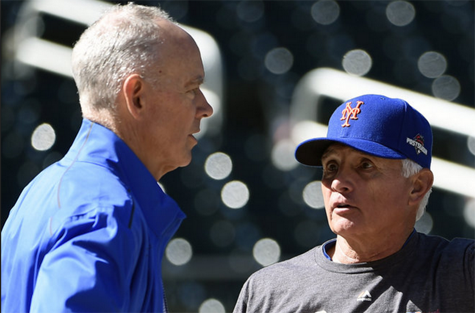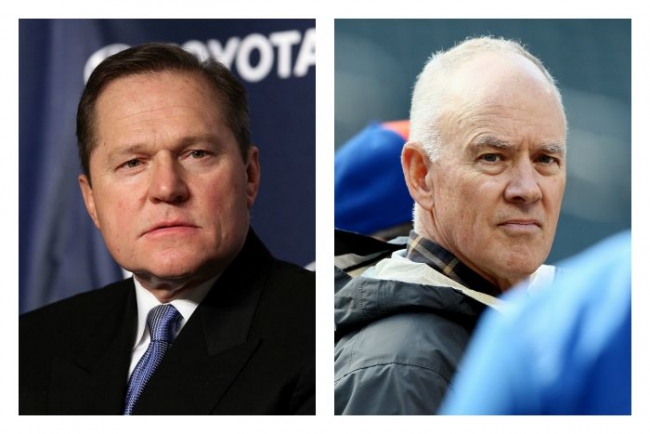
Regardless of what your thoughts are concerning former MLB Commissioner Bud Selig, as a Mets fan you have to consider the fact that he may have had more of an impact on your team’s fortunes than you realize. The Mets in 2010 were a mess with two sub .500 seasons coming on the heels of two gut wrenching late season collapses, all while the Wilpons continued to reel financially from their affiliation with Bernie Madoff and his ponzi scheme. They were probably as close as they’ve ever been to a forced sale at that point, resorting to an emergency 25 million dollar bridge loan from MLB.
Selig was catching heat from both the press and Mets fans over his purported double standard in taking a hard line ousting embattled Dodger’s owner Frank McCourt while he coddled and propped up the Wilpons. His position at the time was that the two situations were fundamentally different and he had the utmost confidence in Mets ownership. All the while the team was searching for a new GM and the name Sandy Alderson came up.
There has been a lot of speculation over just how integral a role Selig played in the Mets hiring of Sandy Alderson, but there are a couple of things that can’t be disputed — Alderson was in Selig’s employ at the time, and Selig did “recommend” Alderson for the job. Steve Kettman in his book Maverick, (and his subsequent interview here on MMO), downplayed Selig’s influence in the hiring, maintaining that the Wilpons insist they were in control of the process the whole time, but you have to wonder. Selig wasn’t exactly known as someone whose recommendation you’d take lightly and Alderson was a high ranking MLB insider with a reputation as a “fix-it” guy. In fact, just prior to the hire, Alderson was in the Dominican Republic as Selig’s point man in MLB’s efforts to correct a host of problems with young developing players — namely predatory agents, PED abuse, and identity manipulation.
Alderson was a guy who’d already served as a GM, Chief Executive of a Major League Baseball team, and as Executive Vice President of MLB. As David Waldstein of the NY Times noted, he was in some respects over-qualified for the Mets job. The Wilpons’ financial outlook would soon go from bad to worse with a significant “clawback” lawsuit brought against them by the trustee representing the victims of Bernie Madoff’s ponzi scheme. MLB ownership, with all it’s new-fangled national media and profit sharing deals, was watching one of it’s premier big-market franchises idle in squalor. That wasn’t good for anyone, so it was definitely in MLB’s best interest to “fix the Mets,” and really, Alderson was tremendously qualified for the job on several levels.

Perhaps most importantly, Alderson had something a lot of other candidates for the Mets job did not. He had some serious clout in MLB circles, and he had a reputation as a guy who placed the cold calculating execution of stated initiatives above whatever inherited rancor, emotional or otherwise, may preside over given challenges.
So regardless of how Mets ownership viewed Alderson, it’s not far fetched to regard him as a de-facto MLB operative similar to Tom Scheiffer’s official role overseeing the Dodgers. The fact that this level of influence was strenuously denied by sources close to Mets ownership, in my mind only reinforces the notion that there’s something to it.
In 2010, perhaps the most coined and damaging criticism of the Mets as an organization was that their ownership was meddlesome to a crippling degree. Alderson effectively negated this interference through sheer organizational prowess — quite possibly the single biggest reason why Paul DePodesta and the rest of the Mets baseball operations people were able to operate unencumbered. It speaks volumes, for instance, that in the Cespedes proceedings Alderson was effectively able to confine Jeff Wilpon’s influence to a single board room vote. There is something to be said for an administrator who knows how to administrate.
But no matter what aspect you choose to view this situation from, there is no disputing that fixing the Mets was a big priority not only for Mets ownership and for the fans, but for MLB.
Selig watched as the Dodgers were packaged and sold for a whopping $2 billion dollars to Magic Johnson and his Guggenheim partnership group. The Dodgers promptly blasted old payroll figures out of the water, becoming the first team to eclipse the Yankees in total payroll since Baltimore in 1998. Now Bud Selig is known for his ability to squeeze money from stones and bramble, so the notion that he did not see the Mets’ situation as a sort of counter-weight to the Dodgers is naive.
Selig has a long history of collusion accusations and crying poverty where there is none (and when it’s convenient) to go along with his personal background as a small market owner. I’m not implying that Selig actively sought to create a small market version of the Mets in New York, I’m saying I don’t see why he’d stand in the way of this happening, perhaps even nudging it along.
The Mets didn’t look like they’d be spending anyhow, why not further whatever corrective actions might be necessary, namely a bridge loan, a vote of confidence, and the installation of a shrewd MLB insider with a reputation as a consummate hatchet man, to ensure that the Mets benefited from their unavoidable austerity?
There’d be no possible way to accuse Selig of conspiring to lower payrolls (as was his wont) because it was clearly established that the Mets were broke. Selig simply facilitated, to the extent his influence allowed, a successful small-market makeover in New York, with the Wilpons’ Madoff debacle providing the perfect cover.

For four years the Mets wallowed in mediocrity and everyone with an interest in spending was unperturbed. 2015 rolls around and just as the Mets appear to be heading towards a playoff berth Scott Boras begins dropping bombs around the issue of Matt Harvey’s arm … Sandy Alderson, MLB, and Scott Boras were never more clearly on opposite ends in terms of their interests.
Was Boras really concerned about his client’s valuable arm, or was he worried about his own bottom line as a player agent whose salary is largely contingent on big free agent contracts? It’s a rhetorical question — the Mets model lays out a virtual blueprint on how to succeed without relying on the very contracts that Boras depends on.
The Dodgers payroll currently sits atop MLB at just under $273 million. The Mets, who just beat LA in the NLDS, come in 21st at $101 million. That’s a difference of $172 million dollars. No matter who makes it to the World Series to op$pose the Mets, the combined payrolls of both teams will be less than what The Dodgers spent.
Say you own a factory in Los Angeles that makes widgets. It costs you $50.00 to make a dozen widgets and you sell your widgets for $100.00 a dozen. Your competitor, Mr. Alderson, also sells them for $100.00 a dozen, but suddenly he develops a means whereby he can produce widgets for a measly $10.00 a dozen. You think you wouldn’t be interested in finding out about what those means are? Your business model would depend on it.
This is why the sudden overwhelming success of the small-marketization experiment in N.Y. is kind of a big deal.
Forget about Kansas City and Oakland, big market success on a small market payroll means a staggering, unprecedented, profit margin. With the player’s pool projected to be as high as $81 million this year, Mets ownership stands to reap anywhere from $50 to $60 million for their share of the post season in the event the Mets win the series. Consider that this figure represents more than half of their current payroll and that there is something like $37 million coming off the books, and you sort of get the picture … that’s not even factoring the $12-13 additional million in 2015 regular season gate proceeds. Money ball, with money, and lots of it.
The take-away is simple. The Mets are in a remarkably fortuitous position moving forward. Even in the event the Mets decide to keep their payroll close to what it is now they’ll have quite a bit of wiggle room. The Mets are also in perhaps the most lucrative market when it comes to making money off of a winning product. There are more than just gate proceeds to factor in, concessions, merchandise sales, ratings, all stand to see big increases.
And as if that weren’t enough, word broke earlier this week that Jeffrey Picower’s widow (Picower was considered to be one of Madoff’s primary co-conspirators) agreed to release $7.2 billion to the trustee representing Madoff victims. Its been a pretty damned good month for the Wilpons.
From A Mets fan’s perspective the big question is whether this means the Mets will start spending again. The Mets will have arbitration increases and free agent vacancies to consider this winter, but should they decide to add even a conservative 10% to their current payroll, that would increase their spending money to something around $47 million. For the short term, that gives them ridiculous flexibility both in terms of adding a big contract as well as filling holes and maybe even offering extensions to some of their young starters. In practice it is precisely the sustainable “cyclical” spending plan that Alderson has been promoting for years.
So, as hard as it may be to fathom at the moment, and as absurd as it may sound, there is more going on here than a trip to the World Series. As fans we can argue until we’re blue in the face over who gets credit for on-field success, but there’s no disputing Sandy Alderson’s impact on the franchise’s finances. He has rebuilt a system which may end up registering record profits over the next few seasons given it’s diminutive payroll, its competitive make up, its rich farm system, and its prime location.
Wait, no, there really isn’t more going on than a trip to the World Series — ultimately that sublime seismic blast is still scattering blue and orange debris in a consciousness where it hasn’t quite registered yet — but you get the idea, a winning NL franchise on a limited payroll in NY, is, financially, kind of a big deal.
















